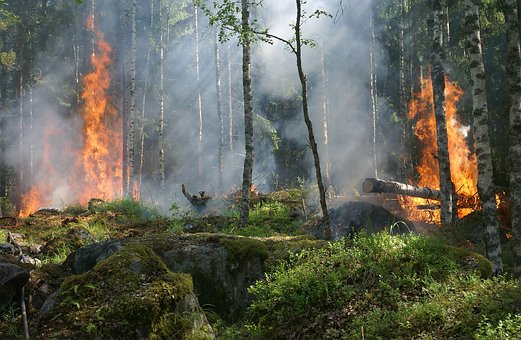 There are certain places in the United States where forest fires occur regularly. California is one while Alaska is another. There are enough fires burning around Fairbanks that the air is extremely smokey from the ground to the sky.
There are certain places in the United States where forest fires occur regularly. California is one while Alaska is another. There are enough fires burning around Fairbanks that the air is extremely smokey from the ground to the sky.Stores are selling out of masks, air purifiers, and furnace filters. I bet you wonder about furnace filters. You put one in the window between the window and the box fan so as it draws air in, it is filtered and healthier.
There are costs and mathematics involved in a forest fire can be both obvious and hidden. Obvious costs include the number of firefighters, firefighting equipment, lost houses, and lost forests but the not so obvious ones include increased illness, increased sales of air purifiers, air masks, etc.
There was a person at Kings College in London who looked at 88,000 fires in the United States between 1970 and 2000. They discovered the fires fit the power-law relationship in that there are way more smaller fires and the numbers of fires decrease as they get larger. In addition as the fires are looked at from east to west, the ratio of smaller fires to larger fires decrease. Furthermore, it has been discovered that wildfires are actually a balance between the equations of energy and fuel. In other words, fuel loss due to being burned relates to the reaction rate of fuel.
Mathematicians have also created computer programs called fire models that allow state and federal agencies to predict how these fires will spread. The results of these programs help officials determine where to focus their firefighters and equipment or evacuate people but these programs cannot always predict sudden changes of direction that happen when the wind direction changes or grow larger.
Computer programers and mathematicians adjusting and fine tuning these programs to include detailed satellite data, and the understanding that fires create their own weather which can cause them to spread even more. Unfortunately, these new programs often take several days to run so the information is not always helpful so officials often resort to the older models. On the other hand, the information from the improved programs can be used to determine what drives a wildfire thus making it easier to figure out how to provide protection to communities in the future.
It has been determined that 84 out of 100 wildfires are started by humans either on purpose or by accident. In addition, human interference has made some fires worse by working to prevent natural fires using a technique called suppression. This policy means there has been more wood on the ground so when a spark hits, there is more fuel for fires and they burn hotter and harder.
There is a group of scientists who are creating a new program to determine how the fires interact with the weather. They've discovered that they can use complex math and fluid dynamics to explain how the air moves after it is heated and how the motion affects the fire. The program is built upon the math used to forecast weather. This aspect explains why fires can suddenly spread even though there is no naturally occurring wind.
Other scientists are looking at how firebrand or embers transfer heat when they land or how fuels burn under various conditions. Embers burn as they fly and its density changes which in turn effects how it flies out from the fire or travels in the air. Furthermore, the characteristics of the ember is based on whether it is from vegetation or a burning building.
Within the scientific community, they are exploring a variety of aspects of wildfires using mathematics so state and federal agencies can use the results from all of these programs to plan their response to different situational fires. It is important because they better they can respond to the situations, the lower the damage.
Let me know what you think, I'd love to hear. Have a great day.
No comments:
Post a Comment